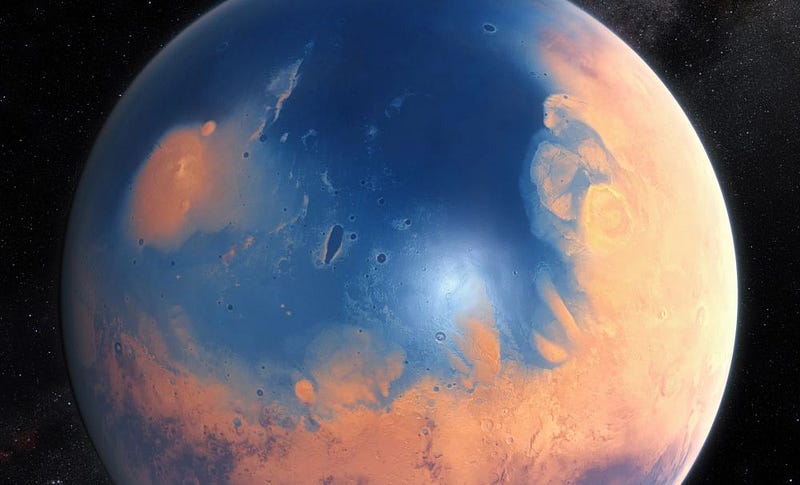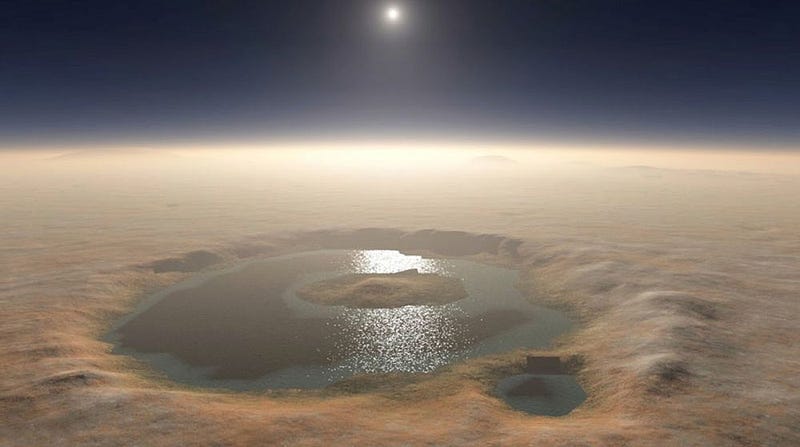Exploring the Ancient Megafloods of Mars and Their Impact
Written on
Chapter 1: The Megaflood Mystery
Mars may have experienced a significant megaflood that transformed the Gale Crater, leaving a lasting impact on its geological features. This event could shed light on ancient waterways and perhaps even the existence of life on the planet.

In its early years, Mars resembled a watery version of Earth. Recent studies utilizing data from the Curiosity rover have unveiled evidence of a colossal flood that occurred billions of years ago. Researchers from Cornell University have presented findings indicating that Gale Crater, investigated by the Curiosity rover, contains signs of this monumental flooding event, believed to have taken place approximately four billion years ago. Such revelations suggest that Mars once featured a climate conducive to the emergence of primitive life.
Join us on Astronomy News with The Cosmic Companion on December 1, when we host Dr. Ezat Heydari, a Geoscience Professor at Jackson State University, to discuss these groundbreaking findings.
“We have identified megafloods for the first time through comprehensive sediment analysis conducted by the Curiosity rover. Prior to this, deposits from such floods had not been recognized using orbiter data,” remarked Alberto Fairén, an astrobiologist at Cornell University.
Section 1.1: Geological Features of the Flood
Evidence collected from the Curiosity rover reveals ancient geological formations on Mars, including megaripples, or antidunes, reaching heights of nearly 10 meters (30 feet). These features are spaced roughly 140 meters (450 feet) apart.
Ezat Heydari highlights that similar formations, formed only two million years ago, can be observed on Earth, where they are produced by melting glaciers.
“Flood-related features consist of symmetrical gravel ridges approximately 10 meters high found in the Hummocky Plains Unit (HPU). Their consistent spacing, internal sedimentary structures, and bedload transport of gravel up to 20 cm in size imply that these formations are antidunes, created by intense water flows,” Heydari and his colleagues explained in their paper published in Scientific Reports.
Subsection 1.1.1: The Noachian Period and Its Significance

The Noachian Period, spanning from approximately 4.1 billion to 3.7 billion years ago, aligns with the Late Heavy Bombardment era characterized by extensive impacts throughout the solar system. During this time, Mars was significantly inundated with water.
Researchers propose that these megaripples emerged due to the heat generated from a major impact on Mars long ago. This colossal event likely released substantial amounts of carbon dioxide, water vapor, and methane from beneath the Martian surface, temporarily warming the planet.
Water vapor would have accumulated in the Martian atmosphere, leading to the formation of clouds and potentially resulting in torrential rainfall across the planet. Gale Crater would have been inundated by massive volumes of water streaming into the basin, including a swift flow cascading down Mount Sharp.
According to the study, water flowing north from the southern region of the crater was at least 24 meters (nearly 80 feet) deep, advancing at speeds of 10 meters per second (20–25 MPH).
The study concludes that these immense flash floods contributed to the gravel ridges observed by the Curiosity rover in both the Hummocky Plains Unit and the Striated Unit, with these formations bearing a striking resemblance to waves in the ground.
The first video explores the investigation of Martian megafloods and how studies of Earth’s ice age floods have enhanced our understanding of ancient Mars.
Section 1.2: The Formation of Gale Crater
Gale Crater, located near the Martian equator, was created over 3.5 billion years ago due to a massive impact from an asteroid. Named after Australian astronomer Walter F. Gale, this crater spans 154 kilometers (96 miles) in diameter.
On August 5, 2012, the Curiosity rover landed at the base of a stratified mountain on Gale Crater's floor. Its findings revealed that this crater was once home to substantial bodies of water, which remained for a considerable duration before Mars lost its surface water to space and concealed underground brine reservoirs.
“There was an ocean above us, held in by a thin sac that might rupture and let down a flood at any second.” — Stephen King, Different Seasons
At the center of the crater lies Mt. Sharp, a crescent-shaped formation of sedimentary rocks measuring 5 kilometers (three miles) across. This peak, named after geologist Robert Sharp, towers higher than Mt. Rainier. The massive canyons on Mt. Sharp include the Grand Canyon of Gale Crater, measuring 2,000 meters (6,500 feet) wide and nearly 90 meters (300 feet) deep.
“Early Mars was a geologically dynamic planet. It had the right conditions to support liquid water on its surface — and where there’s water, there’s life. Thus, early Mars was potentially habitable. The question remains: was it inhabited? The upcoming Perseverance rover will help us find out,” Fairén stated.
As we continue to explore the mysteries of Mars, NASA's Perseverance rover, launched on July 30, 2020, is expected to provide further insights into these ancient megafloods.
The second video discusses the evidence of ancient megafloods on Mars, providing insight into the geological history of the planet.
James Maynard is the founder and publisher of The Cosmic Companion. He is a native of New England who now resides in Tucson with his wife, Nicole, and their cat, Max.
Did you enjoy this article? Join us on The Cosmic Companion Network for our podcast, weekly video series, informative newsletter, news briefings on Amazon Alexa, and more!